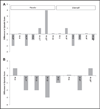Randomized controlled trial of sildenafil for preventing recurrent ischemic priapism in sickle cell disease
- PMID: 24680796
- PMCID: PMC4085689
- DOI: 10.1016/j.amjmed.2014.03.019
Randomized controlled trial of sildenafil for preventing recurrent ischemic priapism in sickle cell disease
Abstract
Background: Successful preventive therapy for ischemic priapism, a disorder of penile erection with major physical and psychologic consequences, is limited. We conducted a randomized, double-blind, placebo-controlled clinical trial to assess the efficacy and safety of sildenafil by a systematic dosing protocol to prevent recurrent ischemic priapism associated with sickle cell disease.
Methods: Thirteen patients with sickle cell disease reporting priapism recurrences at least twice weekly were randomized to receive sildenafil 50 mg or placebo daily, unassociated with sleep or sexual activity, for 8 weeks, followed by open-label use of this sildenafil regimen for an additional 8 weeks.
Results: Priapism frequency reduction by 50% did not differ between sildenafil and placebo groups by intention-to-treat or per protocol analyses (P = 1.0). However, during open-label assessment, 5 of 8 patients (62.5%) by intention-to-treat analysis and 2 of 3 patients (66.7%) by per protocol analysis met this primary efficacy outcome. No significant differences were found between study groups in rates of adverse effects, although major priapism episodes were decreased 4-fold in patients monitored "on-treatment."
Conclusions: Sildenafil use by systematic dosing may offer a strategy to prevent recurrent ischemic priapism in patients with sickle cell disease.
Keywords: Erectile dysfunction; Erection; Nitric oxide; Phosphodiesterase type 5.
Copyright © 2014 Elsevier Inc. All rights reserved.
Conflict of interest statement
Figures

Comment in
-
Prevention of Ischemic Priapism in Sickle Cell Disease: Sildenafil: Commentary on: Randomized Controlled Trial of Sildenafil for Preventing Recurrent Ischemic Priapism in Sickle Cell Disease.Urology. 2015 Dec;86(6):1055-6. doi: 10.1016/j.urology.2015.07.003. Epub 2015 Sep 30. Urology. 2015. PMID: 26431892 No abstract available.
References
-
- Berger R, Billups K, Brock G, et al. Report of the American Foundation for Urologic Disease (AFUD) Thought Leader Panel for evaluation and treatment of priapism. Int J Impot Res. 2001;13(Suppl 5):S39–S43. - PubMed
-
- Montague DK, Jarow J, Broderick GA, et al. American Urological Association guideline on the management of priapism. J Urol. 2003;170(4 Pt 1):1318–1324. - PubMed
-
- El-Bahnasawy MS, Dawood A, Farouk A. Low-flow priapism: risk factors for erectile dysfunction. BJU Int. 2002;89:285–290. - PubMed
-
- Fowler JE, Jr, Koshy M, Strub M, Chinn SK. Priapism associated with the sickle cell hemoglobinopathies: prevalence, natural history and sequelae. J Urol. 1991;145:65–68. - PubMed
-
- Emond AM, Holman R, Hayes RJ, Serjeant GR. Priapism and impotence in homozygous sickle cell disease. Arch Intern Med. 1980;140:1434–1437. - PubMed
Publication types
MeSH terms
Substances
Grants and funding
LinkOut - more resources
Full Text Sources
Other Literature Sources
Medical
Miscellaneous

